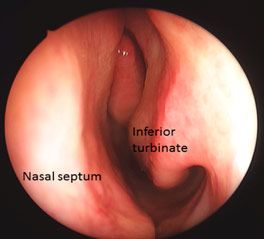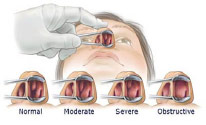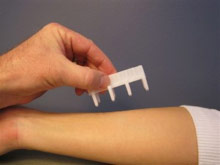What is turbinate hypertrophy?
Question: I have had allergies for as long as I can remember and over the years I have used both prescription and over the counter nasal sprays to help with congestion. The sprays were only used when necessary but over the years I have just tolerated the symptoms associated with allergies. I can no longer breathe through my nose and a friend mentioned that he had experienced similar symptoms. He was later diagnosed with turbinate hypertrophy as the cause of his nasal obstruction. What is turbinate hypertrophy and how does it cause nasal congestion?
Discussion:

Chronic untreated allergies can lead to symptoms of nasal airway obstruction often by causing a condition known as turbinate hypertrophy.
The turbinates are also called the nasal concha and they assist with several functions such as warming, filtering, and shaping the air that we inhale. The turbinates are paired structures that are located within the nasal cavity. Hypertrophy refers to an increase in the size of an organ or tissue; consequently, turbinate hypertrophy is the enlargement of the turbinates. Hypertrophy can occur and result in total obstruction of the nasal airways. Turbinate hypertrophy is very common, yet not many people are familiar with it. It is so common that it affects everyone at some point. Consequently, treatment of allergies and other nasal difficulties is highly advised before complications such as turbinate hypertrophy arise.

In many cases, people with turbinate hypertrophy can no longer breathe through one or both sides of their nose. Some key indications of turbinate hypertrophy would be prolonged nasal congestion and an inability to breathe through one’s nose. Symptoms can range depending on how severe the obstruction is, but the most common symptoms include:
- Nasal congestion
- Mid facial pain
- Pressure in forehead
- Rhinorrhea (occurs when nose has considerable amount of mucus)
Distinguishing between allergy symptoms and turbinate hypertrophy can also be difficult, especially for those who have grown to tolerate their symptoms. Causes of turbinate hypertrophy are not limited to allergy related symptoms and also include the following:
- Upper respiratory infections
- Allergic rhinitis
- Vasomotor rhinitis
- Drugs
- Hormones
- Changes in temperature

Medical therapy is the most common form of treatment used to control turbinate hypertrophy. Surgical therapy is only used for those who do not respond to medical therapy. Nasal decongestants, both in topical (i.e. nasal spray) and oral forms, are effective and reduce congestion. It is important to note that nasal sprays, while effective, can become problematic and lead to eventual worsening of obstructive symptoms if overused. Resistance and tolerance to medications such as oxymetazoline or phenylephrine eventually lead to a dependence on the nasal spray, called rhinitis medicamentosum. These patients experience worsening symptoms when they attempt to discontinue use of these medications.
Oral decongestants are effective and do not cause rebound swelling even after being used for a long period of time. Two common forms of oral decongestants are pseudoephedrine and phenylephrine (Afrin). As with most medications, these treatments are associated with systemic side effects, including increased blood pressure.
|
|
|
Figuring out whether you have turbinate hypertrophy may be difficult but a physician can always be of assistance. All treatment options range in both effectiveness and side effects so it is a good idea to talk to your physician about your individual case.
Key Points:
- Chronic untreated allergies can lead to symptoms of nasal airway obstruction often by causing a condition known as turbinate hypertrophy.
- The nasal turbinates, also known as the nasal concha, assist with several functions including warming, filtering, and shaping the air that we inhale.
- Turbinate hypertrophy is an enlargement of the turbinates that can result in total obstruction of the nasal airways.
- Treatment of allergies and other nasal difficulties is highly advised before complications such as turbinate hypertrophy arise.
- Distinguishing between allergy symptoms and turbinate hypertrophy can also be difficult, especially for those who have grown to tolerate their symptoms.
- Medical therapy is the most common form of treatment used to control turbinate hypertrophy.
- Determining whether you have turbinate hypertrophy can be a difficult task that is best addressed by a qualified otolaryngologist (ENT).





